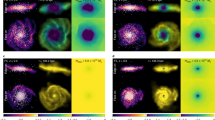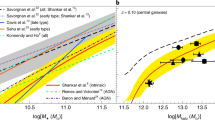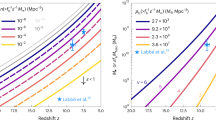Abstract
Current tests of general relativity (GR) remain confined to the scale of stellar systems or the strong gravity regime. A departure from GR on cosmological scales has been advocated1 as an alternative to the cosmological constant Λ (ref. 2) to account for the observed cosmic expansion history3,4. However, such models yield distinct values for the linear growth rate of density perturbations and consequently for the associated galaxy peculiar velocity field. Measurements of the resulting anisotropy of galaxy clustering5,6 have thus been proposed as a powerful probe of the validity of GR on cosmological scales7, but despite substantial efforts8,9, they suffer from systematic errors comparable to statistical uncertainties10. Here, we present the results of a forward-modelling approach that fully exploits the sensitivity of the galaxy velocity field to modifications of GR. We use state-of-the-art high-resolution N-body simulations of a standard GR (Λ cold dark matter (CDM)) model11 and a compelling f(R) model12—one of GR’s simplest variants, in which the Ricci scalar curvature, R, in the Einstein–Hilbert action is replaced by an arbitrary function of R—to build simulated catalogues of stellar-mass-selected galaxies through a robust match to the Sloan Digital Sky Survey13. We find that f(R) fails to reproduce the observed redshift-space clustering on scales of ~1–10 Mpc h−1, where h is the dimensionless Hubble parameter. Instead, the standard ΛCDM GR model agrees impressively well with the data. This result provides strong confirmation, on cosmological scales, of the robustness of Einstein’s general theory of relativity.
This is a preview of subscription content, access via your institution
Access options
Access Nature and 54 other Nature Portfolio journals
Get Nature+, our best-value online-access subscription
$29.99 / 30 days
cancel any time
Subscribe to this journal
Receive 12 digital issues and online access to articles
$119.00 per year
only $9.92 per issue
Buy this article
- Purchase on Springer Link
- Instant access to full article PDF
Prices may be subject to local taxes which are calculated during checkout


Similar content being viewed by others
Data availability
The data that support the plots within this paper and other findings of this study are available from the corresponding author upon reasonable request.
References
Koyama, K. Cosmological tests of modified gravity. Rep. Prog. Phys. 79, 046902–046945 (2016).
Carroll, S. M. The cosmological constant. Living Rev. Rel. 4, 1 (2001).
Perlmutter, S. J. et al. Discovery of a supernova explosion at half the age of the Universe. Nature 391, 51–54 (1998).
Riess, A. G. et al. Observational evidence from supernovae for an accelerating Universe and a cosmological constant. Astron. J. 116, 1009–1038 (1998).
Kaiser, N. Clustering in real space and in redshift space. Mon. Not. R. Astron. Soc. 227, 1–21 (1987).
Peacock, J. A. et al. A measurement of the cosmological mass density from clustering in the 2dF Galaxy Redshift Survey. Nature 410, 169–173 (2001).
Guzzo, L. et al. A test of the nature of cosmic acceleration using galaxy redshift distortions. Nature 451, 541–545 (2008).
Scoccimarro, R. Redshift-space distortions, pairwise velocities and nonlinearities. Phys. Rev. D 70, 083007–083025 (2004).
Taruya, A., Nishimichi, T. & Saito, S. Baryon acoustic oscillations in 2D: modeling redshift-space power spectrum from perturbation theory. Phys. Rev. D 82, 063522–063539 (2010).
de la Torre, S. & Guzzo, L. Modelling non-linear redshift-space distortions in the galaxy clustering pattern: systematic errors on the growth rate parameter. Mon. Not. R. Astron. Soc. 427, 327–342 (2012).
Klypin, A., Yepes, G., Gottlober, S., Prada, F. & Hess, S. MultiDark simulations: the story of dark matter halo concentrations and density profiles. Mon. Not. R. Astron. Soc. 457, 4340–4359 (2016).
Felice, A. D. & Tsujikawa, S. f(R) theories. Living Rev. Rel. 13, 3 (2010).
Abazajian, K. N. et al. The seventh data release of the Sloan Digital Sky Survey. Astrophys. J. Suppl. 182, 543–558 (2009).
Abbott, B. P. et al. GW170817: observation of gravitational waves from a binary neutron star inspiral. Phys. Rev. Lett. 119, 161101–161118 (2017).
Goldstein, A. et al. An ordinary short gamma-ray burst with extraordinary implications: Fermi-GBM detection of GRB 170817A. Astrophys. J. Lett. 848, L14 (2017).
Khoury, J. & Weltman, A. Chameleon fields: awaiting surprises for tests of gravity in space. Phys. Rev. Lett. 93, 171104–171107 (2004).
de la Torre, S. et al. The VIMOS Public Extragalactic Redshift Survey (VIPERS). Gravity test from the combination of redshift-space distortions and galaxy-galaxy lensing at 0.5 < z < 1.2. Astron. Astrophys. 608, A44 (2017).
Blake, C. et al. The WiggleZ Dark Energy Survey: the growth rate of cosmic structure since redshift z=0.9. Mon. Not. R. Astron. Soc. 415, 2876–2891 (2011).
Alam, S. et al. The clustering of galaxies in the completed SDSS-III Baryon Oscillation Spectroscopic Survey: cosmological analysis of the DR12 galaxy sample. Mon. Not. R. Astron. Soc. 470, 2617–2652 (2017).
Vale, A. & Ostriker, J. P. Linking halo mass to galaxy luminosity. Mon. Not. R. Astron. Soc. 353, 189–200 (2004).
Schaye, J. et al. The EAGLE project: simulating the evolution and assembly of galaxies and their environments. Mon. Not. R. Astron. Soc. 446, 521–554 (2015).
Blanton, M. R. et al. NYU-VAGC: a galaxy catalog based on new public surveys. Astron. J. 129, 2562–2578 (2005).
Bruzual, G. & Charlot, S. Stellar population synthesis at the resolution of 2003. Mon. Not. R. Astron. Soc. 344, 1000–1028 (2003).
Conroy, C. Modeling the panchromatic spectral energy distributions of galaxies. Ann. Rev. Astron. Astrophys. 51, 393–455 (2013).
Ade, P. A. R. et al. Planck 2015 results. XIII. Cosmological parameters. Astron. Astrophys. 594, A13 (2016).
Behroozi, P. S., Wechsler, R. H. & Wu, H.-Y. The ROCKSTAR phase-space temporal halo finder and the velocity offsets of cluster cores. Astrophys. J. 762, 109–128 (2013).
Monster, B. P. et al. Constraints on the relationship between stellar mass and halo mass at low and high redshift. Astrophys. J. 710, 903–923 (2010).
McCullagh, N. et al. Revisiting HOD model assumptions: the impact of AGN feedback and assembly bias. Preprint at https://arxiv.org/abs/1705.01988 (2017).
Shi, D., Li, B., Han, J., Gao, L. & Hellwing, W. A. Exploring the liminality: properties of halos and subhalos in borderline f(R) gravity. Mon. Not. R. Astron. Soc. 452, 3179–3191 (2015).
He, J.-H., Hawken, A. J., Li, B. & Guzzo, L. Effective dark matter halo catalogue in f(R) gravity. Phys. Rev. Lett. 115, 071306–071310 (2015).
Hu, W. & Sawicki, I. Models of f(R) cosmic acceleration that evade Solar System tests. Phys. Rev. D 76, 064004–064016 (2007).
Schmidt, F., Vikhlinin, A. & Hu, W. Cluster constraints on f(R) gravity. Phys. Rev. D 80, 083505–083513 (2009).
Fontanot, F., Puchwein, E., Springel, V. & Bianchi, D. Semi-analytic galaxy formation in f(R)-gravity cosmologies. Mon. Not. R. Astron. Soc. 436, 2672–2679 (2013).
van den Bosch, F. C. et al. The importance of satellite quenching for the build-up of the red sequence of present-day galaxies. Mon. Not. R. Astron. Soc. 387, 79–91 (2008).
Chabrier, G. Galactic stellar and substellar initial mass function. Publ. Astron. Soc. Pac. 115, 763–796 (2003).
Kroupa, P. On the variation of the initial mass function. Mon. Not. R. Astron. Soc. 322, 231–246 (2001).
Guo, Q., White, S. D. M., Li, C. & Boylan-Kolchin, M. How do galaxies populate dark matter halos? Mon. Not. R. Astron. Soc. 404, 1111–1120 (2010).
Li, C. & White, S. D. M. The distribution of stellar mass in the low-redshift Universe. Mon. Not. R. Astron. Soc. 398, 2177–2187 (2009).
Blanton, M. R. & Roweis, S. K-corrections and filter transformations in the ultraviolet, optical, and near-infrared. Astron. J. 133, 734–754 (2007).
Yang, X. et al. Galaxy groups in the SDSS DR4: I. The catalogue and basic properties. Astrophys. J. 671, 153–170 (2007).
Davis, M. & Peebles, P. J. E. A survey of galaxy redshifts. V. The two-point position and velocity correlations. Astrophys. J. 267, 465–482 (1983).
Landy, S. D. & Szalay, A. S. Bias and variance of angular correlation functions. Astron. J. 412, 64–71 (1993).
Reid, B. A., Seo, H.-J., Leauthaud, A., Tinker, J. L. & White, M. A 2.5% measurement of the growth rate from small-scale redshift space clustering of SDSS-III CMASS galaxies. Mon. Not. R. Astron. Soc. 444, 476–502 (2014).
Kravtsov, A. V. et al. The dark side of the halo occupation distribution. Astrophys. J. 609, 35–49 (2004).
Conroy, C., Wechsler, R. H. & Kravtsov, A. V. Modeling luminosity-dependent galaxy clustering through cosmic time. Astrophys. J. 647, 201–214 (2006).
Reddick, R. M., Wechsler, R. H., Tinker, J. L. & Behroozi, P. The connection between galaxies and dark matter structures in the local Universe. Astrophys. J. 771, 30–61 (2013).
Chaves-Montero, J. et al. Subhalo abundance matching and assembly bias in the EAGLE simulation. Mon. Not. R. Astron. Soc. 460, 3100–3118 (2016).
Springel, V. The cosmological simulation code GADGET-2. Mon. Not. R. Astron. Soc. 364, 1105–1134 (2005).
Teyssier, R. Cosmology hydrodynamics with adaptive mesh refinement. A new high-resolution code called RAMSES. Astron. Astrophys. 385, 337–364 (2002).
Knollmann, S. R. & Knebe, A. AHF: AMIGA’s Halo Finder. Astrophys. J. Suppl. 182, 608–624 (2009).
He, J.-H., Li, B. & Baugh, C. M. Subhalo abundance matching in f(R) gravity. Phys. Rev. Lett. 117, 221101–221105 (2016).
Smee, S. A. et al. The multi-object, fiber-fed spectrographs for the Sloan Digital Sky Survey and the Baryon Oscillation Spectroscopic Survey. Astron. J. 146, 40–71 (2013).
Hawkins, E. et al. The 2dF Galaxy Redshift Survey: correlation functions, peculiar velocities and the matter density of the Universe. Mon. Not. R. Astron. Soc. 346, 78–96 (2003).
Mohammad, F. G., de la Torre, S., Bianchi, D., Guzzo, L. & Peacock, J. A. Group–galaxy correlations in redshift space as a probe of the growth of structure. Mon. Not. R. Astron. Soc. 458, 1948–1963 (2016).
Acknowledgements
J.H. is supported by a Durham co-fund Junior Research Fellowship; J.H. and B.L. acknowledge support by the European Research Council (ERC-StG-716532-PUNCA); L.G. acknowledges support by the European Research Council (ERC-AdG-291521-Darklight) and by the Italian Space Agency (ASI Grant I/023/12/0); B.L. and C.M.B. are also supported by UK STFC Consolidated Grants ST/P000541/1 and ST/L00075X/1.
Author information
Authors and Affiliations
Contributions
All authors contributed to the development and writing of this paper. J.H. led the data analysis. B.L. conducted and provided the simulations. L.G. led the writing of the paper. C.M.B. and J.H. conceived the idea of data analysis.
Corresponding author
Ethics declarations
Competing interests
The authors declare no competing interests.
Additional information
Publisher’s note: Springer Nature remains neutral with regard to jurisdictional claims in published maps and institutional affiliations.
Supplementary information
Supplementary Information
Supplementary Figures 1–6
Rights and permissions
About this article
Cite this article
He, Jh., Guzzo, L., Li, B. et al. No evidence for modifications of gravity from galaxy motions on cosmological scales. Nat Astron 2, 967–972 (2018). https://doi.org/10.1038/s41550-018-0573-2
Received:
Accepted:
Published:
Issue Date:
DOI: https://doi.org/10.1038/s41550-018-0573-2
This article is cited by
-
Large-scale dark matter simulations
Living Reviews in Computational Astrophysics (2022)
-
Realistic simulations of galaxy formation in f(R) modified gravity
Nature Astronomy (2019)
-
Pancakes and fingers in the sky
Nature Astronomy (2018)



